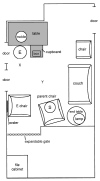Object permanence after a 24-hr delay and leaving the locale of disappearance: the role of memory, space, and identity
- PMID: 15238047
- PMCID: PMC1398789
- DOI: 10.1037/0012-1649.40.4.606
Object permanence after a 24-hr delay and leaving the locale of disappearance: the role of memory, space, and identity
Abstract
Fourteen-month-old infants saw an object hidden inside a container and were removed from the disappearance locale for 24 hr. Upon their return, they searched correctly for the hidden object, demonstrating object permanence and long-term memory. Control infants who saw no disappearance did not search. In Experiment 2, infants returned to see the container either in the same or a different room. Performance by room-change infants dropped to baseline levels, suggesting that infant search for hidden objects is guided by numerical identity. Infants seek the individual object that disappeared, which exists in its original location, not in a different room. A new behavior, identity-verifying search, was discovered and quantified. Implications are drawn for memory, spatial understanding, object permanence, and object identity.
Copyright 2004 APA, all rights reserved
Figures

Similar articles
-
Factors affecting infants' manual search for occluded objects and the genesis of object permanence.Infant Behav Dev. 2008 Apr;31(2):168-80. doi: 10.1016/j.infbeh.2007.10.006. Epub 2007 Nov 26. Infant Behav Dev. 2008. PMID: 18036668 Free PMC article.
-
What do infants remember when they forget? Location and identity in 6-month-olds' memory for objects.Psychol Sci. 2011 Dec;22(12):1500-5. doi: 10.1177/0956797611420165. Epub 2011 Nov 17. Psychol Sci. 2011. PMID: 22095976
-
Infants' search for visible objects: implications for the interpretation of early search errors.J Exp Child Psychol. 1985 Oct;40(2):260-78. doi: 10.1016/0022-0965(85)90089-x. J Exp Child Psychol. 1985. PMID: 4045380
-
Can infants' object concepts be trained?Trends Cogn Sci. 2004 Feb;8(2):49-51. doi: 10.1016/j.tics.2003.12.006. Trends Cogn Sci. 2004. PMID: 15588805 Review.
-
Infants' knowledge of objects: beyond object files and object tracking.Cognition. 2001 Jun;80(1-2):179-213. doi: 10.1016/s0010-0277(00)00154-2. Cognition. 2001. PMID: 11245844 Review.
Cited by
-
Exploring the Relation Between Memory, Gestural Communication, and the Emergence of Language in Infancy: A Longitudinal Study.Infant Child Dev. 2006;15(3):233-249. doi: 10.1002/icd.462. Infant Child Dev. 2006. PMID: 16886041 Free PMC article.
-
The 'like me' framework for recognizing and becoming an intentional agent.Acta Psychol (Amst). 2007 Jan;124(1):26-43. doi: 10.1016/j.actpsy.2006.09.005. Epub 2006 Nov 1. Acta Psychol (Amst). 2007. PMID: 17081488 Free PMC article.
-
Factors affecting infants' manual search for occluded objects and the genesis of object permanence.Infant Behav Dev. 2008 Apr;31(2):168-80. doi: 10.1016/j.infbeh.2007.10.006. Epub 2007 Nov 26. Infant Behav Dev. 2008. PMID: 18036668 Free PMC article.
-
'Like me': a foundation for social cognition.Dev Sci. 2007 Jan;10(1):126-34. doi: 10.1111/j.1467-7687.2007.00574.x. Dev Sci. 2007. PMID: 17181710 Free PMC article.
-
From social contingency to verbal reference: A constructivist hypothesis.Psychol Rev. 2022 Jul;129(4):890-909. doi: 10.1037/rev0000320. Epub 2021 Aug 9. Psychol Rev. 2022. PMID: 34370496 Free PMC article. Review.
References
-
- Acredolo, L. P. (1985). Coordinating perspectives on infant spatial orientation. In R. Cohen (Ed.), The development of spatial cognition (pp. 115–140). Hillsdale, NJ: Erlbaum.
-
- Acredolo LP, Evans D. Developmental changes in the effects of landmarks on infant spatial behavior. Developmental Psychology. 1980;16:312–318.
-
- Baillargeon R. Representing the existence and the location of hidden objects: Object permanence in 6- and 8-month-old infants. Cognition. 1986;23:21– 41. - PubMed
-
- Baillargeon R, DeVos J, Graber M. Location memory in 8-month-old infants in a non-search AB task: Further evidence. Cognitive Development. 1989;4:345–367.

